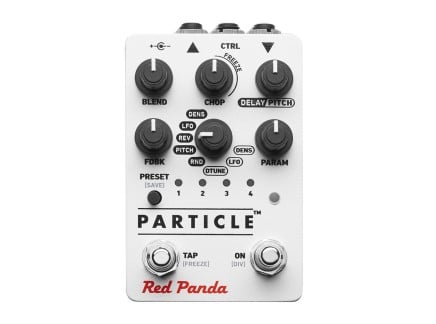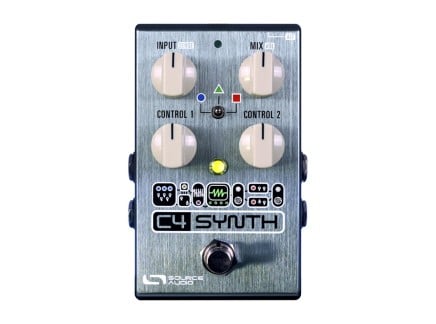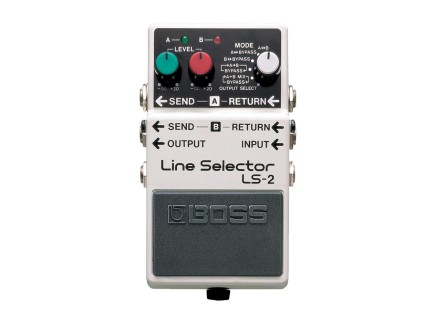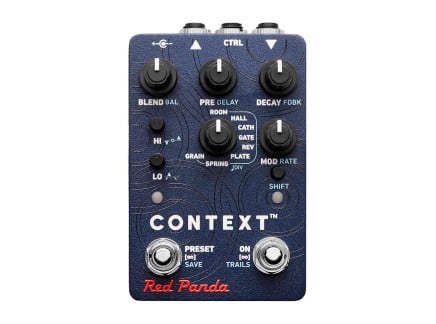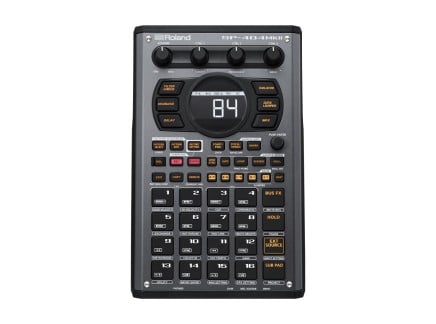It's easy for a piece of gear to sound like itself. Entire genres of music have evolved as a direct consequence of the features/workflows of the devices they employ—and as a result, it can be difficult to break free of a tool's historical baggage. Take the Roland TB-303 Bass Line synthesizer, or a Fender Telecaster, for instance: despite these devices' relative flexibility, they've each become strongly associated with a very specific style of music. As a result, approaching them as a completely blank slate can be difficult. When most people sit down with a 303, for instance, they're either directly seeking to make acid bass lines, or they'll most likely wind up making something that sounds like it, even if that isn't what they intended.
I often think about the artistry of electronic music. Refined mass production and the perfection/consistency of software means that many electronic musicians are using quite literally the same tools as one another. This fact combined with a tendency to gravitate toward any given tool's natural strong suits means that there's an awful lot of music out there that sounds awfully similar. The similarity in workflow between musicians using the same tools means that, in a sense, each software music production environment has its own "sound," for instance. Similarly, many pieces of hardware music gear have their own "sound." To various degrees, even entire categories of device can have "a sound": for instance, phaser pedals strongly evoke the psychedelia of the 1970s, chorus can instantly transport you to the shimmer and warble of 1980s guitar licks and bass lines, flangers and digital delays evoke the slippery-yet-clean textures of 1990s alt rock.
To me, a particularly interesting form of artistry can emerge from an awareness of these ideas. An artist can choose to use specific sonic flavors to evoke a feeling of familiarity, or they can intentionally defy a tool's natural tendencies to turn a familiar sound/workflow into something peculiar and new. And of course, an artist can use both of these approaches: transitioning at a moment's notice between evoking nostalgia and creating something eerily uncanny. Nick Reinhart is one such artist.
Nick recently came by the shop to talk us through some of his recent musical endeavors, specifically discussing his workflow with a small setup comprised of a modified electric guitar, small pedalboard, and a Roland SP-404A sampler. Nick's recent focus has involved a lot of attention to the 404, a device that is very familiar to us—but given his playful, quirky approach to music-making, he uses it in a way fairly dissimilar to what we're used to, and the results are downright fascinating. We're going to take a closer look at this workflow as a whole, but first things first—who is this Nick Reinhart guy, anyway?
Who is Nick Reinhart?
If your musical interests are exclusively occupied by electronic music, it's possible you haven't heard of Nick Reinhart before. If you're a guitarist, though—and especially if you're into effects pedals—you probably know him. Perhaps most famously part of the half-punk, half-math-rock, all-out-weird group Tera Melos, Reinhart's unconventional approach to effect processing makes him one of the most interesting guitarists working today.

With a humorous embrace of the weird, colorful, and kind of messed up/grotesque aspects of '80s/'90s/'00s culture, Reinhart's music is equal parts Sonic Youth, Fugazi, Aphex Twin, Seinfeld, Simpsons, and Hellraiser. And while Tera Melos is probably the best-known of his projects, it's by no means the only one: his recent project Disheveled Cuss is a peculiar ode to '90s alt rock with twisting, knotted song structures and plenty of weird sound design; "supergroup" Big Walnuts Yonder combines the musical talents of Reinhart, Mike Watt, Nels Cline, and Greg Saunier; he has contributed guitar in the violently noisy Death Grips and Undo K From Hot; and of course, Reinhart's solo music is a showcase for many of the other weird corners of his musical activity, from the effect-laden ringtone compilation Cellular Music and alien breakbeats of Halloween Club to the festive holiday collections Scary Sounds and Satan's Power. And of course, Nick (alongside bassist and all-around awesome musician Juan Alderete) is half of the popular YouTube channel Pedals and Effects: an awesome resource full of a particularly fun, gnarly style of effect pedal demos, artist interviews, and more.
So, I've mentioned that much of Reinhart's style as a guitarist hinges on his use of effect pedals—and this bears elaboration. In our conversation with Nick, he described his musical trajectory for us in so many words: he started playing guitar as a kid in punk projects, and developed an interest in using effects pedals while he simultaneously was getting into the music of Aphex Twin, Squarepusher, Underworld, etc. Using a hacked copy of Fruity Loops (eventually transitioning to Reason), he learned the general tools and techniques of electronic music, and over time, this bled into his guitar practice: he developed an approach to guitar where he could emulate aspects of this intricate style of electronic music—using pedals to completely transform the sound of guitar, even "playing" effects rhythmically, tapping different combinations of pedals on and off in order to emulate the sorts of warped fills/stutters/glitches that define that particular flavor of electronic music.
For Reinhart, this approach partly means embracing peculiar effect pedals, yes, but it also means approaching common effects in peculiar ways. Rather than looking to a flanger as a tool for creating jet-like sweeps, for instance, he instead uses it to create energetic blasts of triggered feedback; rather than a digital delay being a way to create clean echoes, it becomes a way to momentarily introduce rapid, jarring, robotic glitches; instead of a pitch shifter being a way to create simple harmonies, it becomes a way to create continuous, cartoon-like sweeps in pitch. This is a very David Tudor-like approach to music-making: instead of approaching a tool in the way it is "intended" to behave, you can simply approach it for what it does in a very literal way—and by breaking free of the baggage of its suggested use or its historical context, you can turn even a very familiar tool into a weird and surprising source of sonic inspiration. From my perspective, the embrace of a cartoon-like quirkiness and a consistent defiance of his tools' "intended" uses has come to define Reinhart's style, and as we'll see going forward, that summary seems to fit his current style of experimentation.
Because he has his hands in so many different projects, we didn't know quite what to expect when Nick came to visit. Ultimately, he decided to talk us through a setup/workflow he's been exploring recently that involves a modified Fender Jaguar running into a small pedalboard, and then into a Roland SP-404 for sampling/resampling/general performative sound mangling. Let's take a look more closely at each part of this setup.
What's Up With That Guitar?
The guitar Nick used for this setup is a bizarre and fantastic extension of the Jaguar's natural quirkiness. Anyone who has spent time playing a Fender offset guitar (especially a Jaguar or Jazzmaster) should be very familiar with some of their mechanical peculiarities—in fact, many of these peculiarities are "features" that attract experimental guitarists to these specific instruments.
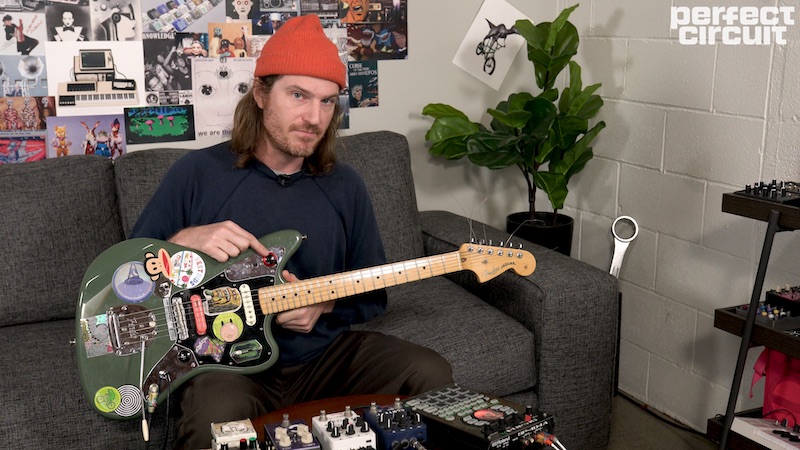
Because of the way the bridge and trem/vibrato arm on Jaguars/Jazzmasters works, there is a significant exposed length of string behind the bridge, which can be plucked to produce weird, high pitched resonances; the trem/vibrato system itself can create its own mechanical noise; and because of its weird means of pickup selection and their use of independent "lead/rhythm" tone circuits, the Jaguar in particular has a lot more switches and metal hardware than the typical electric guitar. This means that the guitar itself makes a lot of mechanical/acoustic noise outside the context of what the strings and pickups alone can do. Most players tune this out—but players like Nick put a contact mic on their guitar, because why the hell not?
Nick's Jaguar has a contact mic installed on the tone circuit switch plate, and he has replaced the lead circuit's master tone knob with a separate output jack for the contact mic itself. This makes it easy to exploit some of the weirder "non-musical" sounds these guitars can produce—picking up the switches, behind-the-bridge area, untrimmed strings at the headstock, and even providing a kind of weirder, lo-fi version of the sound of the strings themselves. As such, this guitar can do all of the normal guitar stuff—notes, chords, and the like—but at a moment's notice, it can turn into a percussive noise instrument with a wide variety of taps, scrapes, plucks, and clangs. If you've never put a contact mic on a guitar...you should definitely give it a shot. Notes and chords aside, guitars actually sound pretty dang weird.
The Pedal Board
Then comes the pedalboard, featuring a Boss LS-2 Line Selector, Source Audio C4, Red Panda Particle 2, and Red Panda Context 2. Now, it's worth noting here that if you've ever been to a Tera Melos or Reinhart solo show, you're probably used to seeing him with as many as 30 or so pedals, so seeing how he boils down his setup to a mere four pedals is a lesson in maximizing the utility of a small setup. As such, let's take a look at each of these individual pieces.
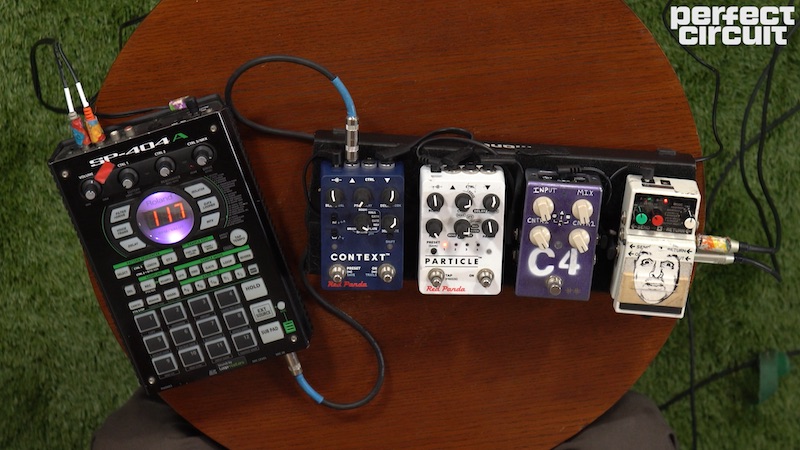
The Boss LS-2 is a general-purpose signal router/effect loop pedal commonly used for setups where players need to switch between multiple instruments or multiple signal paths on the same pedalboard. In Nick's case, he's using it to switch between the guitar's pickups and the contact mic. Pretty clever.
Source Audio's C4 is an uncommonly flexible guitar synth pedal. For those of us who grew up playing the Digitech Synth Wah and Boss SYB-5, the C4 is something of a revelation: a highly-programmable synthesizer-in-a-pedal that uses Source Audio's Neuro app/desktop editor for creating presets. In designing C4, Source Audio sought to pack the power of workflow of a Eurorack modular synthesizer into a single pedal with a minimal user interface. As a result, it can be used to create everything from squave wave synth bass lines to uncanny vocal wahs, layered arpeggio-like sequences, and much more. If you're looking for a single pedal to transform your instrument's sound in a ridiculous number of ways, it's a solid choice—you can get started by using presets from Source Audio's own library, or use the Neuro editor to dive deep designing your own new guitar synth sounds.
Red Panda's Particle 2 is a granular delay/pitch shift pedal in a class of its own—allowing everything from relatively straightforward delay and pitch shifting all the way to creating clouds of dynamically responsive, latching granular textures. If you want an instrument to go into a pedal and come out sounding like something completely different, Particle 2 is an excellent choice: notes go in, and stutters, glitches, and evolving textures come out. Red Panda's Context 2 is similarly flexible: a studio-quality reverb that can successfully emulate the sounds of classic algorithmic reverbs and well beyond. Sure, you can use it for simple spring, plate, room, or hall reverbs...but you can also modulate it, use the grain or reverse modes, add delay in all modes, and much more, allowing you to go from "realistic space" to absolutely otherworldly textures in no time.
One of the things I think is pertinent to note about these particular effects is that each of them is so dense, and often capable of achieving several different types of effects in a single box. Moreover, given the ease of access to different user presets (especially on C4 and Particle 2), you can drastically change each pedal's behavior at a moment's notice. Combining their uncommon flexibility with the ease of access to vastly different presets means that this pedalboard, despite only having three processors on it, can do an insane amount. Combine that with the option to process either the guitar's pickups or the contact mic and you've suddenly got a pretty rad setup for experimenting with all sorts of sounds...and we haven't even talked about the SP-404 yet.
The Roland SP-404...is a Fancy DL4
Like his use of pedals, Nick's use of the SP-404 is pretty interesting. In our conversation with him, we asked why he specifically gravitated to the 404 as a sampler—a question I was particularly keen on knowing the answer to, as it has such a strong association with lo-fi hip hop...which isn't exactly what we're used to hearing from him. His response was multifaceted: basically, he'd been using several models of Boss and Roland samplers for years, a friend loaned him the SP-404A, and around the time he started getting interested in exploring it, it seemed like he was noticing an influx of SP-404-centric lo-fi beats on social media...leading him to, of course, try to see how he could take its unique sampling workflow and do something different. (Note—Nick's using the now-discontinued SP-404A, but you should be able to do these sorts of tricks with the newly-released SP-404 MkII as well!)
In the video above, Nick walks us through this entire workflow in depth—basically, the guitar/contact mic runs into the pedalboard, which then runs into the 404's mic input, allowing him to sample any given sound from the guitar and pedals onto a specific pad of the 404. He first lays down a gnarly foundational beat using the contact mic processed through the Particle, creating a sound where each new tap on the guitar transforms into a metallic, glitchy, psuedo-tonal burst of short delay. He trims and resamples this, adding a layer of sampled kick and snare. Eventually, he records additional samples: a wonky guitar-into-C4 synthy bassline, a Particle-heavy peculiar rhythmic loop which isn't explicitly synced to the initial foundational loop, and a vocal sample captured by singing into the contact mic on the guitar while manually adjusting settings on the Context. Of course, as with any 404-centric piece, this all hinges on loads of resampling as well—using built-in effects and compression to create altered, resampled versions of the initial sound sources.
What's particularly interesting to me is that, while so much music on the 404 heavily relies on using the built-in effect processor, Reinhart instead focuses on capturing samples with a lot of their own quirky character. His particular choice of sound sources and pedals makes for a huge variety of sounds, such that he can actually go quite far without needing to rely on the 404's built-in effects, which play a huge role in defining "the" 404 sound. It's a simple idea, but actually does a lot to keep things from sounding quite so..."samey" as a lot of 404-based music. As you heard in the video, Nick's use of the 404 is anything but typical—instead of lo-fi beats, we get an unapologetically bizarre and fun onslaught of glitchy alien rhythms.

One interesting note about Reinhart's use of the 404 is its similarity to his use of the Line 6 DL4 Delay Modeler, as he mentions in the video. For those not familiar, the DL4 is a multi-mode delay pedal with a particularly interesting looper/sampling seciton. This looper is a definitive part of many musicians' playing styles—such as Minus the Bear's Dave Knudson and (surprise!) Nick Reinhart. The particularly interesting features of the looper/sampler function on the DL4 are that it allows you to use the footswitches to reverse playback, to do double-speed or half-speed playback, and to switch between continuous loop playback and one-shot playback, using one of the footswitches as a "trigger" to begin playback. It's pretty rad, and is used all over Tera Melos's music—Nick will often use some combination of pedals to make a bizarre set of sounds, quickly sample them on the DL4, and then use the various playback options to create weird, triggerable chopped-up textures.
He uses the SP-404 in a similar way—using the "Reverse" button as a performative effect and using the built-in effects to chop up and manipulate his prepared sample material. Coming mostly from the world of synths and effect pedals, I have to admit that I've never quite considered the 404 this way—and once you wrap your head around thinking of the 404 like a super-expanded version of the DL4's sampling capabilities, it suddenly becomes easy to think of it outside its context as a lo-fi beat-making workstation and see it for what it really is: a quirky, general-purpose tool for recording, editing, playing back, and generally screwing with sound.
The Takeaway? Try Using Stuff Wrong
Seeing Nick's performance and writing this article has been a fun thought exercise—as I said before, it can be all too easy to fall into a piece of gear's "normal" workflow in a way where we completely ignore much of its potential. Similarly, many people think that to achieve a particular sound, you need to have a specific set of tools...and as such, people often amass new gear for every single project based on "the sound" that they are trying to achieve.
One of the most refreshing aspects of Nick's music is his willingness to ignore what any given piece of gear is for and instead search for something unique to any given device, be it a sampler, a pedal, or even a guitar. And as a result, on everything he does, and no matter the gear he uses, he has a sound that seems more like him than it seems like the result of any specific piece of gear. Similarly, in conversation, he mentioned that people often ask him about his guitar practice regime—and as he told us, his "practice" is exactly the sort of thing he demonstrates in our video: in-depth exploration of some specific technique, or some specific combination of gear. Not hours of scales and arpeggios—just intuitively following his creative impulses.
My biggest takeaway? If you approach any device with a sense of curiosity, you'll be able to find interesting sounds...and if you trust your personal musical intuition, you'll most likely be able to find a way to use whatever sounds you discover. The idea that any particular piece of gear is for any particular style of music is simply untrue, and as long as you have a strong sense of the types of sounds you like and a willingness to get into the weeds with whatever gear you have at hand, you'll no doubt come up with something that sounds like you. Just have fun with it.

